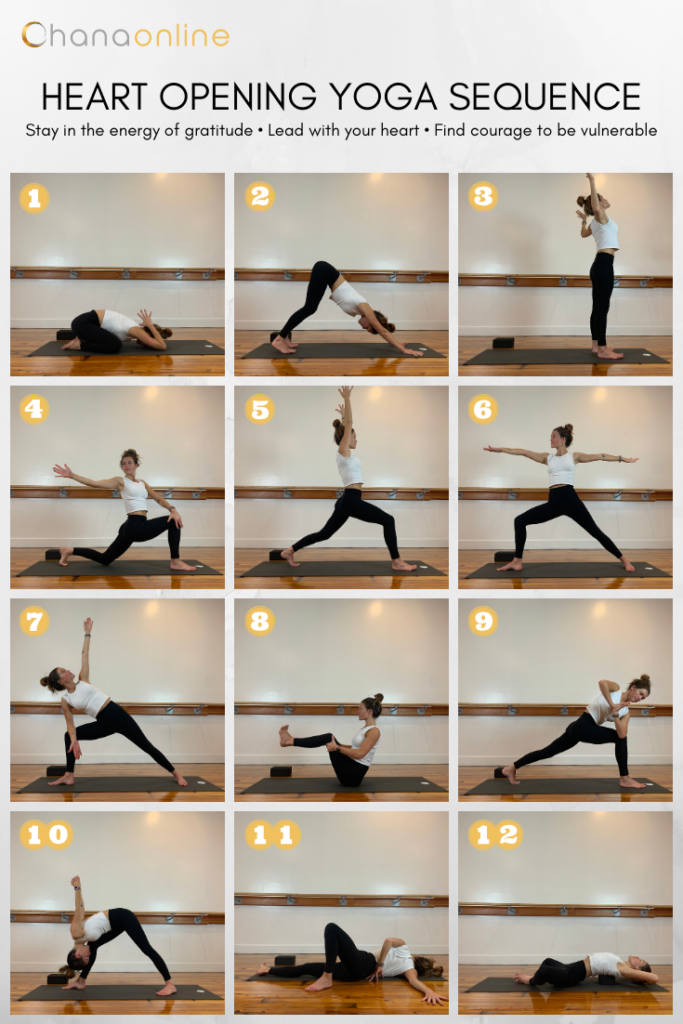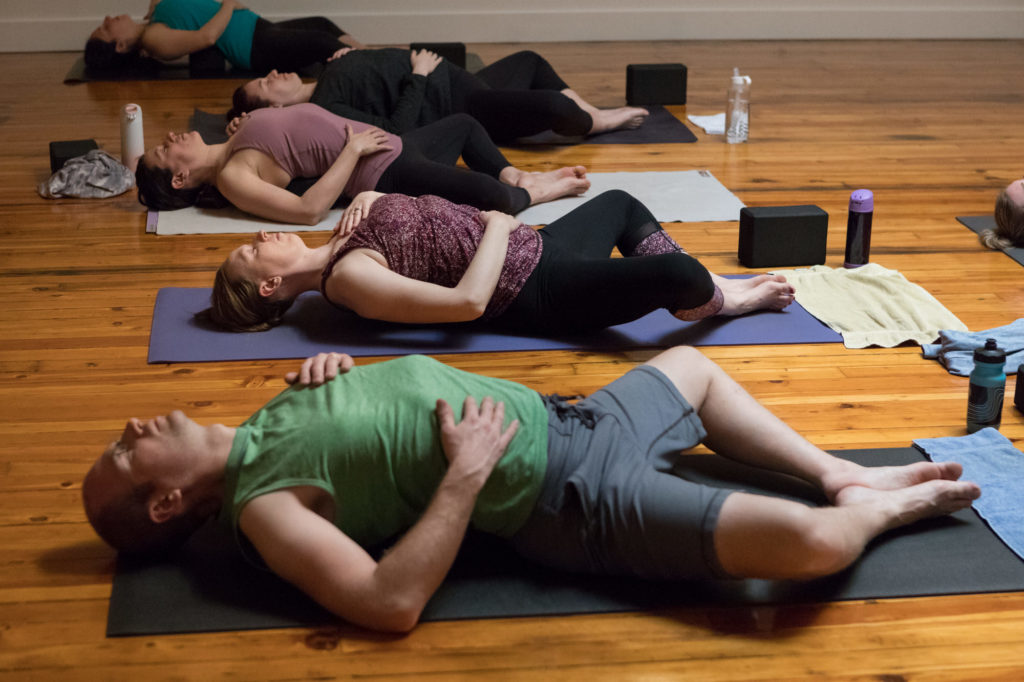The season of gratitude and joy has officially made its swift entry. As we all know very well, this is the season of giving… But how do we do that when we feel so exhausted and depleted? Our gentle yoga flow for heart-opening is a good start!
It’s a phenomenon of our society that we do so much work around the holiday season, and yet are expected to be cheerful. It’s something we yearn for, but then we’re bogged down by shopping, cooking, cleaning, and all the things.
As the age-old saying goes, you can’t give from an empty cup. You have to fill your cup first before you prioritize others — that is if you want to enjoy the seasons of gratitude even a little bit. And this is where our yoga practice steps in. Especially a soothing, gentle yoga flow.
When life gets crazy, we are tempted to sacrifice our yoga practice. We swap it out for the more pressing items on our to-do list and then find ourselves wiped out at the end of the day. It’s not a winning strategy.
If we want to indulge in the giving of the season, and enjoy the process, we need a devoted practice of self care.
If we want to indulge in the giving of the season and enjoy the process, we need a devoted practice of self-care. And a regular yoga practice is the perfect way to do that.
When times get hard, you can lean on a gentle yoga flow to soften tense muscles and soothe an anxious mind. When family drama is running high, you sift through it on the mat. We need a place where the overflowing emotions and thoughts can come back down to a calm simmer — and that place is your practice.
Sometimes it’s hard to get a practice in at the yoga studio. But you don’t need a full hour to get the benefits of a yoga practice. You’ll see — just a few postures and breath can make a huge difference in your presence and well-being.
To support you in a joyful and stressless experience through the holiday season, we’ve created this heart-opening slow-flow yoga. This flow is designed to help you keep the love and gratitude flowing, even when it’s challenging.
When we keep the heart open, all things end well. We find ourselves more satisfied with how our experiences unfold because we know we acted from love and kindness, instead of stress and judgment.
Unroll your mat and practice these postures. Feel free to add in any other poses or transitions that you love; allow your creative juices to flow as you bring this sequence to life.

1. Child’s Pose Variation [Hold for as long as you’d like]
Start your practice in Child’s Pose. Draw your big toes together to touch, and widen your knees. Rest your forehead down on the floor.
Stretch your hands forward and bring them together into prayer, thumbs facing up. Bend your elbows and connect your thumbs to the nape of your neck.
Find gentle length in the triceps as you press your elbows into the mat. Allow your heart to soften toward the floor. Focus on the opening surrounding the under-arms.
2. Downward Facing Dog [Hold for 5-10 slow breaths]
From Child’s Pose, you can make your way up to Table Top, all fours. Feel free to find cat/cows here or any other spinal movement that feels amazing.
When you’re ready, move into Down Dog. Tuck your toes beneath you and lift your hips to the ceiling. Start with your knees bent to free up your low back. Lift the base of your seat, and feel the stretch extend down the back of your legs.
Gentle hug your belly inward. Squeeze your arms toward each other as you wrap the outside of your shoulders toward the ground. Push your hands firmly into the mat, as though you’re pushing extra inches into the extension of your spine. Relax your neck.
3. Mountain Pose with Backbend [3-5 Breaths]
Make your way up to Mountain Pose however you’d like — standing, with arms reaching up. You can stop in a Forward Fold along the way if that sounds good to your body.
Build your Mountain from the ground up. Your feet can be hip-width distance or together, whatever feels best for your pelvis. Distribute the weight equally through the soles of your feet. Find a gentle bend in the knees as you engage your quadriceps.
Lengthen your tailbone toward the floor as you wrap your core inward. Lift your rib cage higher away from your waistline. Reach your arms to the ceiling, but melt the shoulders.
As you feel ready for it, invite a small backbend. Take your arms out to a goal-post shape. Feel the backbend right behind your heart. Squeeze your elbows behind you as if they could meet behind your head. Lift your breastbone to the ceiling. Keep your core hugging in tightly the entire time.
Notice how the backbend feels in your body. If it feels vulnerable to open the chest wide, or uncomfortable, try to breathe into that sensation. Observe the quality of experience that unfolds as you open into your front body. When you’re finished with the backbend, come back to Mountain Pose.
4. Crescent Moon with Vertical Twist [Hold for 5-10 Breaths]
Make your way into a lunge with the right foot forward. To find Crescent Moon, drop your back knee to the floor, and lift your torso; arms to the ceiling.
Squeeze your inner thighs together, as you send your pelvis forward. Notice the opening on the front of your left hip. Wrap your right hip crease toward the wall behind you. Feel Mountain Pose in your upper body.
On an exhale breath, Vertical Twist to the right. Reach your right arm to the back wall, and your left arm forward. You can always grab onto your right thigh with your left hand, to help the twist.
Prioritize the length in your spine as you deepen your twist. Feel the rotation surrounding the heart space, and the concurrent mobility and space you’re creating there. Reach up through the crown of your head. Tuck your chin back toward your throat.
When you’re finished, take the second side. (Left foot forward, Vertical Twist to the left.)
After both sides are complete, step back to Downward Facing Dog.
5. Crescent Lunge [5 breaths]
Step your right foot through to a Low Lunge. Then, keeping your back knee lifted, raise your torso; arms to the ceiling.
Lift your left heel high so that your foot is perpendicular to the floor. Drive your right shinbone forward. Press your inner thighs toward each other for more stability. Use the reach of your fingertips to find more side body length.
Notice that even though you aren’t in a deliberate backbend, there’s still a sense of opening in the chest. A lifting of sorts. Keep your focus on your heart center, and the sensations which evolve there, throughout this practice.
6. Warrior Two [5-10 breaths]
From Crescent Lunge, drop your back heel down and open your body to the left. Your arms now extend to the front and back of the room.
Focus on opening your right knee over the ankle, toward the pinky toe side of the foot. Lower your right thigh down. Allow your hips to splay naturally toward the side of the room. But keep your back leg pressed firmly toward the ground.
Again, you aren’t in a deliberate heart opener here. But can you feel the heart lift toward the sky? Can you create that heart opening feeling in your body, just through intention? Even as the posture gets challenging to hold, maintain your awareness on open chest.
7. Extended Side Angle [5-10 breaths]
From Warrior Two, lower your right forearm to your right inner thigh. Extend your left arm to the ceiling. Challenge the side bodies to get longer.
Use the connection of your right arm to the inner thigh to press the knee open. Rotate the right side of your torso to the ceiling. Anchor the back foot into the floor again.
Continue to encourage the heart to rotate toward the ceiling. Pull your left shoulder close toward your spine to make more space for the chest opening.
***Repeat 5, 6, and 7 on the left side before moving forward.
8. Boat Pose [5-10 breaths]
Time to build a bit of core strength. Find your seat. Bend your knees, keeping your feet flat on the floor for now.
Grab onto the base of your hamstrings, and gently pull on the legs to lift your heart up toward the ceiling. Dig your sitting bones into the floor, and feel that extend the spine skyward. Wrap your shoulders back and lift your heart high.
Squeeze your side bodies inward. Feel your low and deep belly band engage to keep the extension in the spine. Feel free to hover your feet off the floor, and perhaps lift your arms to the ceiling. Hold until you feel stronger in your core. Embrace all feelings of shakiness, as this is truly the process of becoming strong.
9. Revolved Crescent Lunge [5 breaths]
Make your way back into Downward Facing Dog. Move into Low Lunge with the right leg forward. Liftback into Crescent Lunge, where you’ve already been once before.
Draw your hands together in front of your heart. Lengthen your spine forward on a diagonal, and twist your left elbow to the outside of your right thigh. If this proves to be overly challenging your balance, drop down to the left knee.
Squeeze your inner thighs together for stability. Lengthen both of your side bodies forward, as you rotate your left chest toward your thumbs. Keep thinking about an open heart as you lift your heart to the sky. Retract your top shoulder and breathe across your chest, and to the front of your shoulders.
10. Humbled Warrior [5 breaths]
From Revolved Crescent Lunge, return to Crescent Lunge. Step your back foot in slightly, and land it flat on the floor at a 45-degree angle for Warrior One. Your left toes should be pointing toward the top left corner of your mat, and your heel should be rooted firmly to the floor.
Take your hands into a bind at your low back. You can either interlace your fingers into a fist or grab opposite elbows, like Ragdoll behind your back. As you inhale, lift your heart to the ceiling and widen your chest. As you exhale, fold your upper body forward to the space inside your right knee.
Keep anchoring through your back foot. Wrap your right hip crease toward the back wall. Engage your inner thighs to mid-line to maintain the squaring of your hips. Hollow your belly and fold deeper toward the ground. Eventually, shift your gaze toward your belly button. If you feel wobbly, squeeze your inner thighs together more.
***Repeat 10 and 11 on the left side before moving forward.
11. Alligator Stretch [Hold for as long as you’d like]
Lie down flat on your stomach. Take your arms out to a ‘T’ shape, and make sure that your right thumb is in line with your nose. Use your left hand to help you push and roll over onto your right side body. Your left leg can come up and over and serve as a kickstand. It is important that your right arm did not move as you rolled to your side.
Relax your head down to the floor. You can keep your left hand in front of you or tuck it behind your back like a half-bind. Breath into the stretch at the front of the right shoulder. While this stretch is intense, you should not feel any pain. If you feel pain, adjust until you feel only stretch.
Repeat on the second side.
12. Supported Fish Pose Variation [Hold for as long as you’d like.]
Find a seat. Grab your block, and set it the flattest and widest way, on the floor. You will lie down on the block so that the width of it stretches across the width of your shoulder blades. Basically, the block should be propping up the backside of your heart. Drop the back of your head to the floor and feel your throat open.
If it feels okay in your body, you can take your feet together, allowing the knees to fall open to each side. You can also take your hands behind your head for more shoulder opening.
As you hold this posture, notice how it invites your heart to become the peak of your body. This pose invokes a huge opening for the chest, so be aware of whatever sensations, thoughts, and emotions rise within the experience. Try to stay with the feeling of opening, even when it feels a bit uncomfortable.
Memorize the feeling of your heart being so wide open. Imagine if you could spend the rest of your wakeful hours with such open body language. Know that the space you’re creating here will stay with you, far beyond the close of your practice.
Feel free to take your Savasana in this posture. Or, when you’re finished, you can remove the block and lie flat in a traditional Savasana for as long as you’d like to wrap up your practice.

Why Do We Do Heart Openers in Yoga?
Any heart-opening yoga practice that you do is powerful on different levels. By incorporating these postures into your practice, you can experience benefits physically, mentally, emotionally, socially, and spiritually. Here are a few benefits of heart openers:
- Physical: Increase mobility of the ribcage and thus increase breath intake, increase thoracic spine flexibility, a stretch of the chest and shoulders
- Mental: Decrease stress and tension in the mind, open-mindedness, general relaxation
- Emotional: Increase comfort in vulnerability, cultivate compassion and empathy, bringing more love and acceptance into all relationships
- Social: Increase tolerance, understanding, non-judgment
- Spiritual: Opening into 4th chakra, Anahata
We hope this slow-flow yoga inspires a delightful practice If you have any questions about it, leave them in the comments below!

Devon Barrow is a yoga teacher for Ohana Yoga + Barre, our amazing social media manager, and a talented teacher for the YTT program. Yoga has been a part of Devon’s life since she was nine years old and continues to be her agent of healing and health. You’ll find both creativity of the physical body and the power of mindfulness in her classes.